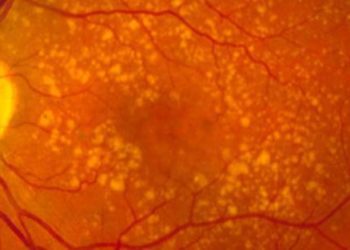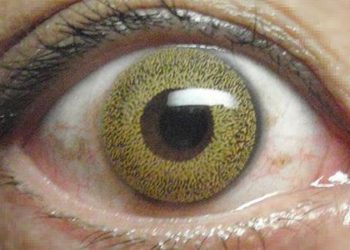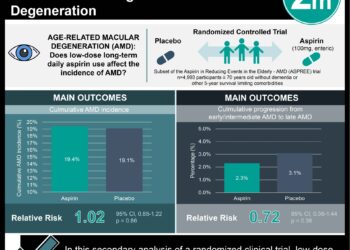Combination of corticosteroid and nonsteroidal anti-inflammatory drug eye drops non-superior to nonsteroidal anti-inflammatory drug monotherapy and sub-Tenon depot for postoperative macular thickening after cataract surgery
1. The findings demonstrated non-superiority of using a combination of prednisolone and nonsteroidal anti-inflammatory drug eye drops compared to nonsteroidal anti-inflammatory drug monotherapy and sub-Tenon capsule depot in preventing thickening of the central subfield after uncomplicated cataract surgery.
2. Nonsteroidal anti-inflammatory drug monotherapy initiated on the day of surgery may be preferred as an anti-inflammatory prophylactic regimen in uncomplicated cataract surgery.
Evidence Rating Level: 1 (Excellent)
Study Rundown: Macular edema caused by inflammatory response after cataract surgery occurs in a subset of patients, affecting visual acuity and postoperative outcomes. To control the inflammatory response and reduce the risk of fluid leakage into the retina and consequently macular thickening, prophylactic anti-inflammatory eye drops are prescribed parallel to cataract surgery. However, the choice of anti-inflammatory prophylaxis and algorithm for postoperative decision-making has not been established, with 2 common regimens currently available: corticosteroids and nonsteroidal anti-inflammatory drugs (NSAIDs). This randomized clinical trial sought to determine whether a combination of prednisolone and NSAID eye drops was superior in preventing macular thickening after uncomplicated cataract surgery compared to NSAID monotherapy and dropless surgery using a sub-Tenon capsule dexamethasone phosphate depot. In addition, the trial examined whether preoperative initiation of eye drop treatment was superior to initiating treatment on the day of surgery. The primary endpoint of the trial was central macular thickness, as determined through the central subfield thickness (CST) 3 months postoperatively. Among 470 patients, no statistically significant differences in CST or visual acuity were observed across the 5 anti-inflammatory prophylactic treatment arms, although approximately half of the participants in the sub-Tenon group required additional anti-inflammatory treatment. These findings demonstrated non-superiority of using a combination of prednisolone and NSAID eye drops as well as the initiation of prophylactic treatment 3 days preoperatively when compared to NSAID monotherapy and initiation of treatment on the day of surgery respectively in preventing thickening of the central subfield after uncomplicated cataract surgery. Furthermore, dropless surgery with a sub-Tenon dexamethasone depot was found to be inferior to a combination of prednisolone and NSAID eye drops as demonstrated by the additional anti-inflammatory treatment required in a substantial number of patients in the sub-Tenon group. Therefore, NSAID monotherapy initiated on the day of surgery may be preferred as an anti-inflammatory prophylactic regimen in uncomplicated cataract surgery. A limitation of this study was the sole inclusion of patients with an expected low risk of complications postoperatively, excluding patients with common risk factors such as diabetes and thus, limiting the generalizability of the study results to low-risk patients.
Click to read the study in JAMA Ophthalmology
In-Depth [randomized controlled trial]: This single-center, randomized clinical trial enrolled 470 patients (mean [SD] age, 72.2 [7.0] years; 290 women [61.7%]) from the Department of Ophthalmology, Rigshospitalet Glostrup, Glostrup, Denmark between February 2018 to August 2019, with follow-up through December 2019 and masked data analysis completed in June 2020. Eligible patients were low-risk undergoing phacoemulsification for age-related cataract by an experienced surgeon. Patients were randomized to receive 1 of 5 anti-inflammatory prophylactic regimens after uncomplicated cataract surgery (94 patients per group): 1) preoperative prednisolone (1%) plus NSAID (ketorolac tromethamine 0.5%, control group), 2) postoperative prednisolone plus NSAID, 3) preoperative NSAID, 4) postoperative NSAID, and 5) sub-Tenon group (dexamethasone phosphate). Eye drops were administered 3 times daily until 3 weeks postoperatively. Three months postoperatively, the mean CST was 250.7 (95%CI, 247.6-253.7) μm in the preoperative prednisolone plus NSAID group, 250.7 (95%CI, 247.8-253.7) μm in the postoperative prednisolone plus NSAID group, 251.3 (95%CI, 248.2-254.4) μm in the preoperative NSAID group, 249.2 (95%CI, 246.2-252.3) μm in the postoperative NSAID group, and 255.2 (95%CI, 252.0-258.3) μm in the sub-Tenon group. Differences in CST or visual acuity were non-significant when compared with control, as were differences between preoperative and postoperative cohorts. However, 47/83 patients (56.6%) in the sub-Tenon group required further anti-inflammatory treatment.
Image: PD
©2021 2 Minute Medicine, Inc. All rights reserved. No works may be reproduced without expressed written consent from 2 Minute Medicine, Inc. Inquire about licensing here. No article should be construed as medical advice and is not intended as such by the authors or by 2 Minute Medicine, Inc.






